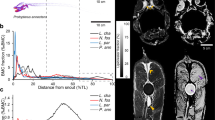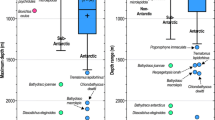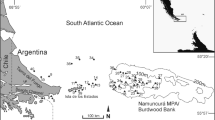Abstract
The radiation of notothenioid fishes (Perciformes) in Antarctic waters was likely the result of an absence of competition in the isolated Antarctic waters and key traits such as the production of antifreeze glycoprotein and buoyancy modifications. Although notothenioids lack a swim bladder, the buoyancy of Antarctic species, ranging from neutrally buoyant to relatively heavy, corresponds to diverse life styles. The buoyancy of South American notothenioids has not been studied. Static buoyancy was measured in adult notothenioids (n = 263, from six species of the sub-order Notothenioidei, families Bovichtidae, Eleginopidae, Nototheniidae, and Harpagiferidae) from the Beagle Channel. Measurements were expressed as percentage buoyancy (%B). Buoyancy ranged from 3.88 to 6.96% (median, 4.0–6.7%), and therefore, all species could be considered benthic consistent with previous studies that found that neutral buoyancy in notothenioids is rare. Harpagifer bispinis, Patagonotothen cornucola, and Cottoperca gobio were significantly less buoyant than Paranotothenia magellanica. The buoyancy values of most species were concordant with known habitat preferences. These data, especially the data of C. gobio (sister lineage of all other nototehnioids) and E. maclovinus (sister lineage of the Antarctic clade of notothenioids), could be useful for understanding the diversification of this feature during the notothenioid radiation.


Similar content being viewed by others
References
Bligh EG, Dyer WJ (1959) A rapid method of total lipid extraction and purification. Can J Physiol Pharm 37:911–917
Calvo J, Morriconi E, Rae GA, San Roman NA (1992) Evidence of protandry in a subantartic notothenid, Eleginops maclovinus (Cuv.&Val., 1830) from the Beagle Channel, Argentina. J Fish Biol 40:157–164
Carroll NV, Longley RW, Roe JH (1956) The determination of glycogen in liver and muscle by use of anthrone reagent. J Biol Chem 220:583–593
Ceballos SG, Fernández DA (2006) Estudio preliminar del desarrollo temprano de Patagonotothen tessellata a temperatura de invierno (4°C) en el Canal de Beagle. In: VI Jornadas de Ciencias del Mar, Puerto Madryn, Argentina
Clarke A, Johnston IA (1996) Evolution and adaptive radiation of Antarctic fishes. Trends Ecol Evol 11:212–217
Clarke A, Doherty N, De Vries AL, Eastman JT (1984) Lipid content and composition of the three species of Antarctic fish in relation to buoyancy. Polar Biol 3:77–83
Eastman JT (1993) Antarctic Fish Biology: evolution in an unique environment. Academic Press, San Diego
Eastman JT (2005) The nature of the diversity of Antarctic fishes. Polar Biol 28:93–107
Eastman JT, De Vries AL (1982) Buoyancy studies of notothenioids fishes in McMurdo Sound, Antarctica. Copeia 2:385–393
Eastman JT, De Vries AL (1985) Adaptations for cryopelagic life in the Antarctic notothenioid fish Pagothenia borchrevinki. Polar Biol 4:45–52
Eastman JT, Sidell BD (2002) Measurements of buoyancy for some Antarctic notothenioid fishes from the South Shetland Islands. Polar Biol 25:753–760
Fernández DA, Calvo J, Franklin CE, Johnston IA (2000) Muscle fibre types and size distribution in sub-antarctic notothenioid fishes. J Fish Biol 56:1295–1311
Fernández D, Calvo J, Wakeling J, Vanella F, Johnston I (2002) Escape performance in the sub-Antarctic notothenioid fish Eleginops maclovinus. Polar Biol 25:914–920
Friedrich C, Hagen W (1994) Lipid contents of five species of notothenioid fish from high Antarctic waters and their ecological implications. Polar Biol 14:359–369
Gosztonyi A (1980) Biología del róbalo (Eleginops maclovinus Cuv. & Val., 1830). Dissertation, University of La Plata
Johnston IA, Calvo J, Guderley H, Fernandez DA, Palmer L (1998) Latitudinal variation in the abundance and oxidative capacities of muscle mitochondria in perciform fishes. J Exp Biol 201:1–12
Johnston IA, Fernández DA, Calvo J, Vieira VL, North AW, Abercromby M, Garland T Jr (2003) Reduction in muscle fibre number during the adaptive radiation of notothenioid fishes: a phylogenetic perspective. J Exp Biol 206:2595–2609
Licandeo RR, Barrientos CA, González MA (2006) Age, growth rates, sex change and feeding habits of notothenioid fish Eleginops maclovinus from the central-southern Chilean coast. Environ Biol Fish 77:51–61
Lloris D, Rucabado J (1991) Ictiofauna del Canal Beagle (Tierra del Fuego), aspectos ecológicos y análisis biogeográfico. Instituto Español de Oceanografía, Madrid
López HL, García ML, San Román NA (1996) Lista comentada de la ictiofauna del Canal Beagle. Contribución Científica CADIC, Tierra del Fuego
Lowry OH, Rosebrough NJ, Farr AL, Randall RJ (1951) Protein measurement with the Folin phenol reagent. J Biol Chem 193:265–275
Marshall NB (1960) Swimbladder structure of deep-sea fishes in relation to their systematics and biology. Discov Reports 31:1–122
Marshall NB (1979) Developments in deep-sea biology. Blandford Press, Poole
McCune AR, Carlson RL (2004) Twenty ways to lose your bladder: common natural mutants in zebrafish and widespread convergence of swim bladder loss among teleost fishes. Evol Dev 6:246–259. doi:10.1111/j.1525-142X.2004.04030.x
Moreno CA, Jara H (1984) Ecological studies on fish fauna associated with Macrocystis pyrifera belts in the south Fueguian Island, Chile. Mar Ecol Prog Ser 15:99–107
Near TJ, Kendrick BJ, William Detrich H, Jones CD (2007) Confirmation of neutral buoyancy in Aethotaxis mitopteryx DeWitt (Notothenioidei: Nototheniidae). Polar Biol 30:443–447
Phleger CF, Nichols PD, Erb E, Williams R (1999) Lipids of the notothenioid fishes Trematomus spp. and Pagothenia borchgrevinki from East Antarctica. Polar Biol 22:241–247
Rae GA, Calvo J (1995a) Annual gonadal cycle and reproduction in Patagonotothen tessellata (Richardson, 1845) (Nototheniiidae: Pisces) from Beagle Channel (Argentina). J Appl Ichthyol 11:60–70
Rae GA, Calvo J (1995b) Fecundity and reproductive habits in Patagonotothen tessellata (Richardson, 1845) from the Beagle Channel, Argentina. Antarct Sci 7:235–240
Seifter S, Dayton S (1950) The estimation of glycogen with the anthrone reagent. Arch Biochem 25:191–200
Steen JB (1970) The swim bladder as a hydrostatic organ. In: Hoar Ws, Randall DJ (eds) Fish physiology. The nervous system, circulation, and respiration, vol 6, pp 413–443
Vanella FA, Calvo J (2005) Influence of temperature, habitat and body mass an routine metabolic rates of sub-antarctic teleosts. Sci Marina 69:317–323
Vanella FA, Fernández DA, Romero M, Calvo J (2007) Changes in the fish fauna associated with a sub-Antarctic Macrocystis pyrifera kelp forest in response to canopy removal. Polar Biol 30:449–457
Vanella FA, Boy CC, Lattuca ME, Calvo J (2010) Temperature influence on post-prandial metabolic rate of sub-Antarctic teleost fish. Comp Biochem Physiol A Mol Integr Physiol 156:247–254
Veas ER (1998) Tasa de crecimiento en relación al cambio de sexo en el róbalo Eleginops maclovinus (Valenciennes, 1830) (Pisces: Eleginopsidae) en la zona de la desembocadura del río Bio–Bio, Chile. Dissertation, Universidad de Concepción
Acknowledgments
We would like to thank Tomás Chalde, Facundo Llompart, Eliana Tetamanzi and Eugenia Di Fiore for sampling assistance. We would like to thank Daniel Aureliano, Sonia Rimbau, Marcelo Gutierrez, Mariela Victorio and Eliana Gonzales for lab assistance. We would like to acknowledge Dr. Jorge Calvo for his intellectual input into the project. We would like to thank Joe Eastman, Tom Near and an anonymous reviewer for constructive comments on the original manuscript. Sheryl Macnie and Sandy Becker provided English editorial assistance. Funds for the project were provided by Agencia PICT 38152 and PICT 906, and CONICET PIP 6187.
Author information
Authors and Affiliations
Corresponding author
Rights and permissions
About this article
Cite this article
Fernández, D.A., Ceballos, S.G., Malanga, G. et al. Buoyancy of sub-Antarctic notothenioids including the sister lineage of all other notothenioids (Bovichtidae). Polar Biol 35, 99–106 (2012). https://doi.org/10.1007/s00300-011-1037-7
Received:
Revised:
Accepted:
Published:
Issue Date:
DOI: https://doi.org/10.1007/s00300-011-1037-7




